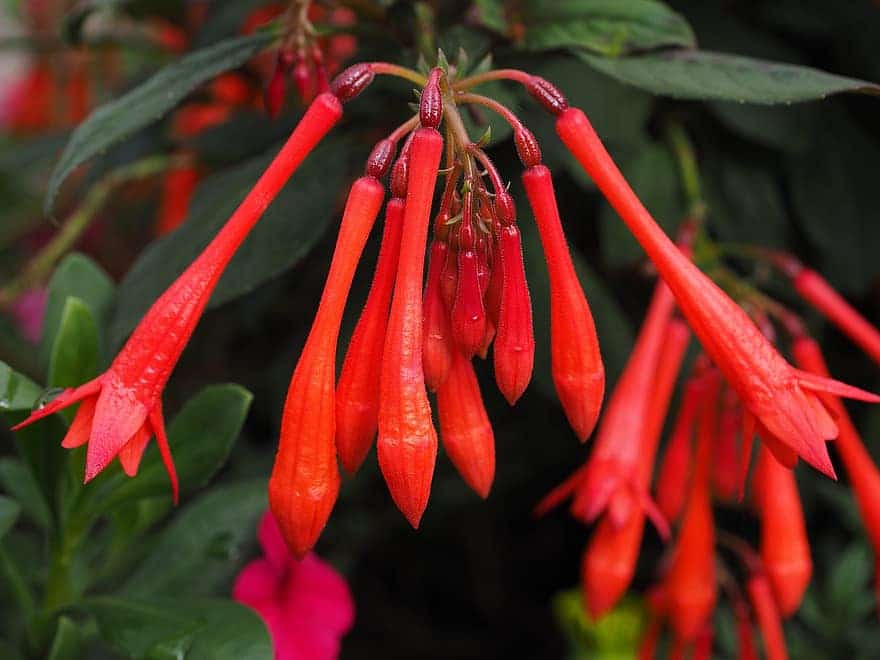If you want to know how to grow fuchsias in a greenhouse, you’ll be pleased to simplify the steps into planting and maintenance. Fuchsias are one of the most beautiful and exotic-looking flowers, so it’s no surprise that everyone is interested in growing them. But because it can be challenging to predict the outdoor conditions, there is also a growing interest in greenhouse fuchsias.
Did you know that it’s also possible to overwinter fuchsias in an unheated greenhouse? This plant has many hardy cultivars to choose from, and with proper preparation and planning in the greenhouse, you shouldn’t have any problem regardless of the season. However, the emphasis is necessary on your state’s planting zone as fuchsias are best for zones 6 to 11.

How To Grow Fuchsias In A Greenhouse: Tips And Tricks
Planting
Before you start planting, you must know which fuchsia would be best for greenhouse gardening. Two of the suitable kinds for the greenhouse are Fuchsia fulgens and Fuchsia splendens. The former gives off orange-red flowers, while the old have scarlet and green flowers.
According to Clemson Cooperative Extension, fuchsias will thrive best in an area that receives indirect yet bright sunlight. Avoid letting the temperature go over 76°F as this prevents flowering, so make sure your greenhouse is at 60 to 70°F in the day and 55 to 60°F in the night. The cold night temperatures are essential for the plant’s growth in early spring, where it is just starting to develop buds.
For the rooted cuttings, use pots that are as small as 3 inches or as big as 10 inches. Like other plants, make sure the growing media is fertile with good drainage and a pH of 6.0 to 6.5. You can pot the rooted cuttings in spring while repotting for larger fuchsia plants is best in February.
Maintenance
Pinching or stopping the shoots several times is a common practice in fuchsia plants. This results in bushy and well-branched fuchsias, so check on your plant regularly and begin pinching when you see three sets of leaves.
Pinch off the stem above the third pair of leaves and dispose of the foliage that will fall to avoid diseases from spreading. You can continuously pinch after every two sets of leaves appear on each new stem. It’s also common to pinch off spent flowers and remove berries in the entire growing season to encourage healthy blooming.
In the summer, remember to maintain ventilation and a cold and airy environment in the greenhouse. For times when the greenhouse needs heating, fuchsias will thrive in 40 to 45°F. And as for the lighting requirements, it’s best to have moderate to low lighting.
Feeding and watering fuchsias in the greenhouse are quite simple, where you must water when the soil surface is dry in the growing season. It would help if you also extended the periods between watering in the fall to prepare dormancy in the winter. As for the feeding, give your fuchsias fertilizer every 2 to 4 weeks while growing as these plants are heavy feeders.
Common Problems In Growing Fuchsias In A Greenhouse
The common problems in greenhouse fuchsias are abnormal conditions, pests, and diseases. Remember the recommended temperatures as the buds will fail to develop otherwise. For the pests, you can expect snails, slugs, whiteflies, aphids, spider mites, mealybugs, thrips, leaf miners, and scales.
The common diseases that you might encounter in the greenhouse gardening of fuchsia are rust, gray mold, powdery mildew, black root rot, Phytophthora, and Phytium. The good news is that cultivars are resistant to rust, and practices like good air circulation, proper spacing, and sanitation can prevent mold. For control of the diseases, you can try broad-spectrum fungicides.
Overwintering Fuchsias In A Greenhouse
A fantastic characteristic of fuchsias is that you can overwinter them for up to 3 years. You can even overwinter fuchsias in an unheated greenhouse. Start by decreasing the amount of water in November and make cuts on each stem above a node.
Remember to also remove all the leaves on your plants to prevent fungal diseases. Once you’re done, remove an inch of soil at the top of the pot and wrap it with paper. Place the covered pot horizontally in a cardboard box and seal it with a lid.
Put this box in the greenhouse area with temperatures between 32 to 40°F. Over the winter, maintain the soil as barely moist without overwatering. Overwatering is a common cause of problems in overwintering fuchsias.
Once the weather gets milder, allow the plant to breathe by opening the box and the greenhouse door to prevent fungi growth. You can also treat your plant to kill gall mite eggs.
Conclusion
Even in an unheated greenhouse, it’s possible to overwinter fuchsias. You can learn how to grow fuchsias in a greenhouse by being aware of your growing zone and the specific requirements. And while diseases and pests are possible in greenhouse fuchsias, proper practices will quickly help you avoid them.
Like most greenhouse flowers, your fuchsias’ success depends on your preparation, patience, and effort to learn the tips and tricks of greenhouse gardening. There are many cultivars to choose from, so you should find the best match for your location.
